Research Proposal: Cash Flow and SME Sustainability in Australia
VerifiedAdded on 2020/03/16
|18
|4045
|5604
Project
AI Summary
This research proposal investigates the critical issues of cash flow management and its impact on the sustainability and survival of Small and Medium Enterprises (SMEs) in Australia. The study addresses the significant contributions of SMEs to the Australian economy, highlighting the challenges posed by poor cash flow management, especially in the face of economic downturns and global market pressures. The proposal is structured into three sections, beginning with an introduction that outlines the problem statement, research objectives, and justification for the study. Section II details the conceptual framework, research hypotheses, and methodology, while Section III focuses on the organization of the study, including a Gantt chart and budget. The research aims to identify the specific challenges SMEs face, such as delayed payments, limited financial resources, and the impact of these issues on their financial health and growth. The anticipated outcomes include providing insights into effective cash flow management strategies for SMEs, contributing to academic understanding, and offering practical guidance for entrepreneurs to enhance their financial stability and competitiveness.
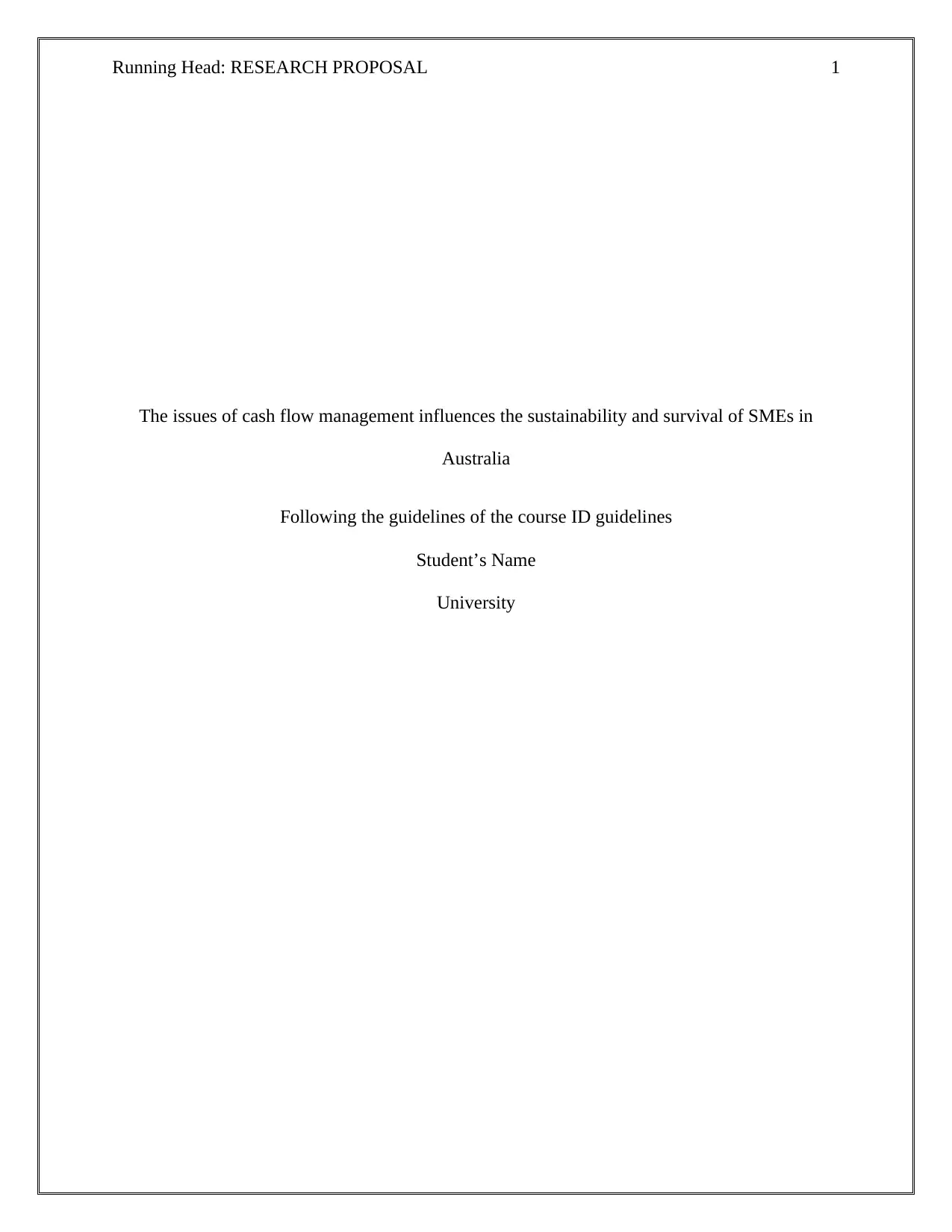
Running Head: RESEARCH PROPOSAL 1
The issues of cash flow management influences the sustainability and survival of SMEs in
Australia
Following the guidelines of the course ID guidelines
Student’s Name
University
The issues of cash flow management influences the sustainability and survival of SMEs in
Australia
Following the guidelines of the course ID guidelines
Student’s Name
University
Paraphrase This Document
Need a fresh take? Get an instant paraphrase of this document with our AI Paraphraser
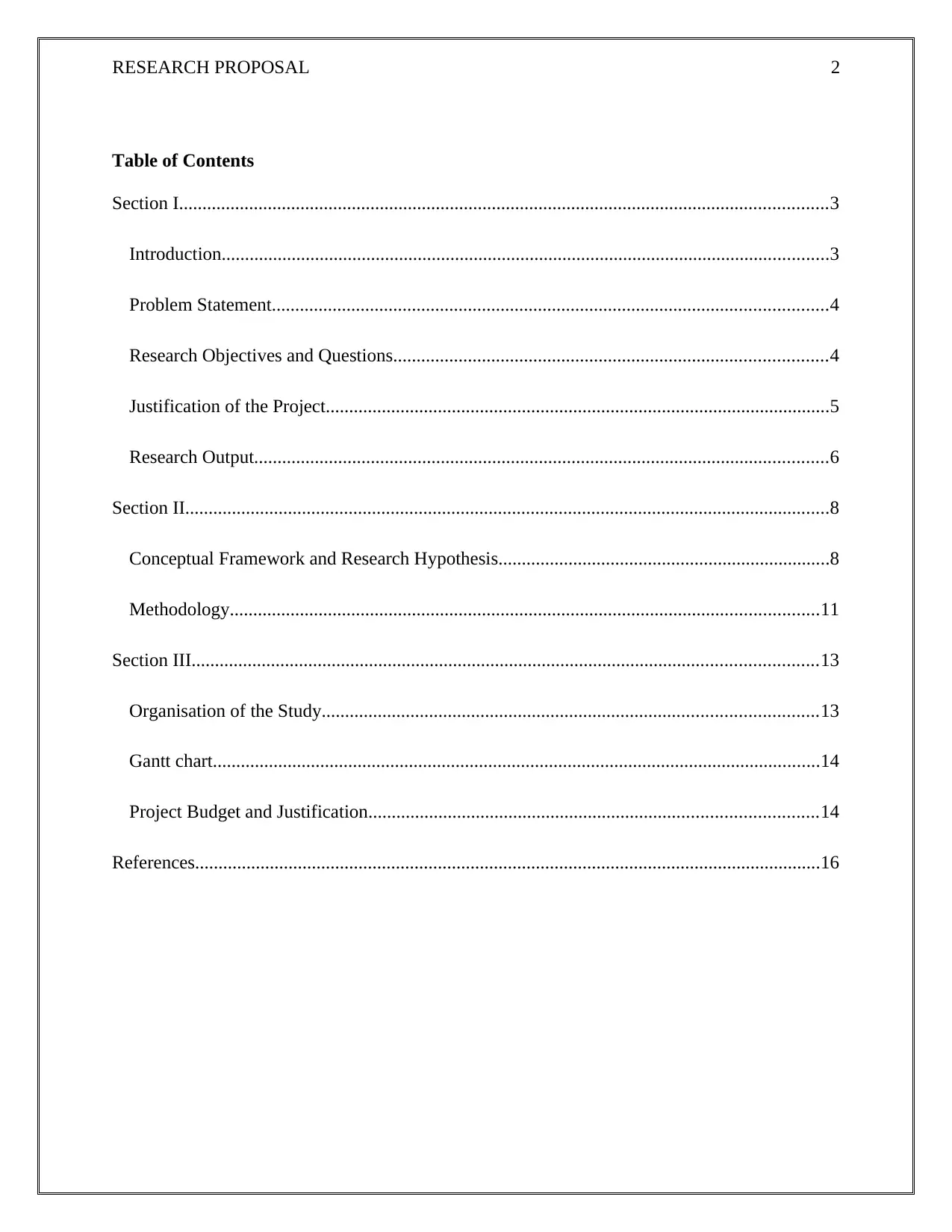
RESEARCH PROPOSAL 2
Table of Contents
Section I...........................................................................................................................................3
Introduction..................................................................................................................................3
Problem Statement.......................................................................................................................4
Research Objectives and Questions.............................................................................................4
Justification of the Project............................................................................................................5
Research Output...........................................................................................................................6
Section II..........................................................................................................................................8
Conceptual Framework and Research Hypothesis.......................................................................8
Methodology..............................................................................................................................11
Section III......................................................................................................................................13
Organisation of the Study..........................................................................................................13
Gantt chart..................................................................................................................................14
Project Budget and Justification................................................................................................14
References......................................................................................................................................16
Table of Contents
Section I...........................................................................................................................................3
Introduction..................................................................................................................................3
Problem Statement.......................................................................................................................4
Research Objectives and Questions.............................................................................................4
Justification of the Project............................................................................................................5
Research Output...........................................................................................................................6
Section II..........................................................................................................................................8
Conceptual Framework and Research Hypothesis.......................................................................8
Methodology..............................................................................................................................11
Section III......................................................................................................................................13
Organisation of the Study..........................................................................................................13
Gantt chart..................................................................................................................................14
Project Budget and Justification................................................................................................14
References......................................................................................................................................16
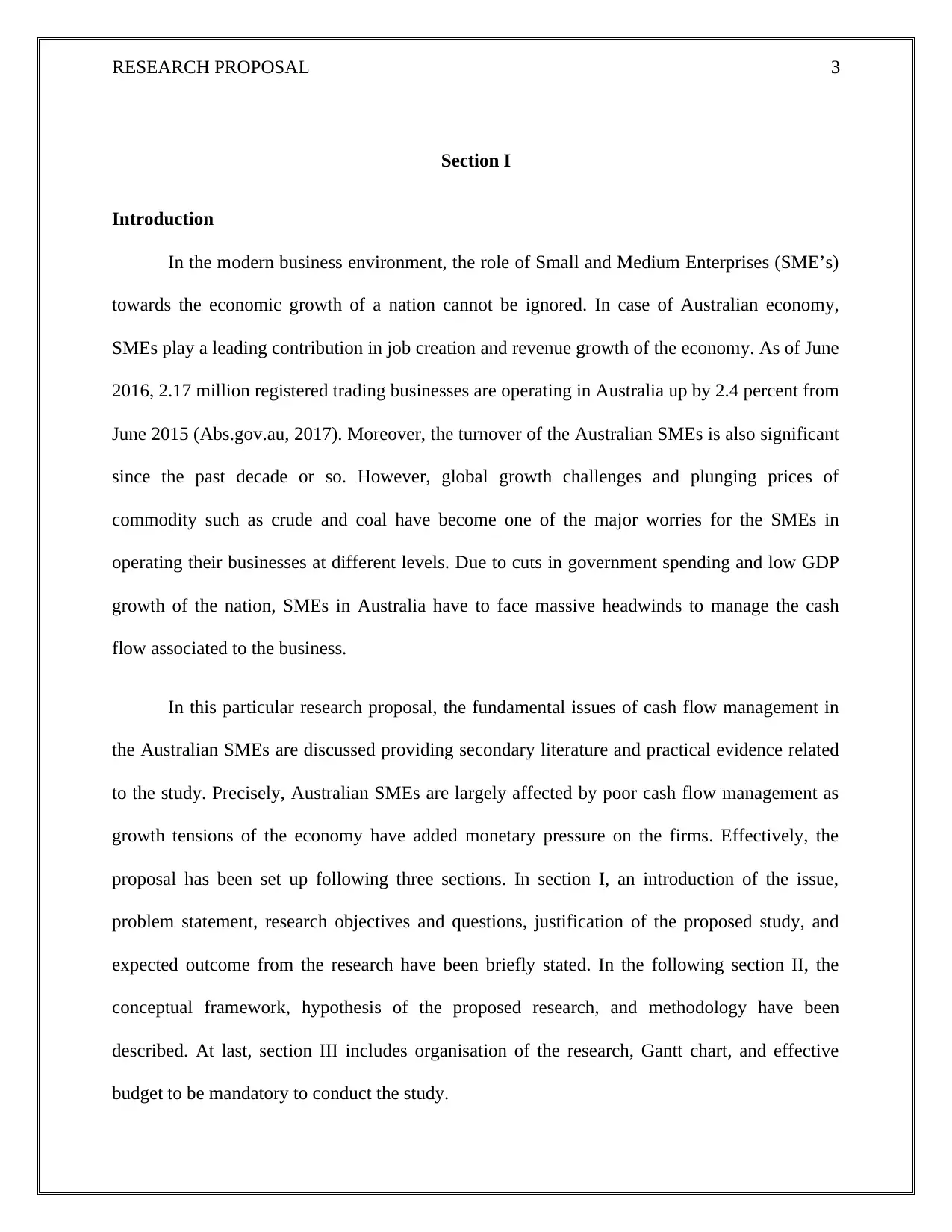
RESEARCH PROPOSAL 3
Section I
Introduction
In the modern business environment, the role of Small and Medium Enterprises (SME’s)
towards the economic growth of a nation cannot be ignored. In case of Australian economy,
SMEs play a leading contribution in job creation and revenue growth of the economy. As of June
2016, 2.17 million registered trading businesses are operating in Australia up by 2.4 percent from
June 2015 (Abs.gov.au, 2017). Moreover, the turnover of the Australian SMEs is also significant
since the past decade or so. However, global growth challenges and plunging prices of
commodity such as crude and coal have become one of the major worries for the SMEs in
operating their businesses at different levels. Due to cuts in government spending and low GDP
growth of the nation, SMEs in Australia have to face massive headwinds to manage the cash
flow associated to the business.
In this particular research proposal, the fundamental issues of cash flow management in
the Australian SMEs are discussed providing secondary literature and practical evidence related
to the study. Precisely, Australian SMEs are largely affected by poor cash flow management as
growth tensions of the economy have added monetary pressure on the firms. Effectively, the
proposal has been set up following three sections. In section I, an introduction of the issue,
problem statement, research objectives and questions, justification of the proposed study, and
expected outcome from the research have been briefly stated. In the following section II, the
conceptual framework, hypothesis of the proposed research, and methodology have been
described. At last, section III includes organisation of the research, Gantt chart, and effective
budget to be mandatory to conduct the study.
Section I
Introduction
In the modern business environment, the role of Small and Medium Enterprises (SME’s)
towards the economic growth of a nation cannot be ignored. In case of Australian economy,
SMEs play a leading contribution in job creation and revenue growth of the economy. As of June
2016, 2.17 million registered trading businesses are operating in Australia up by 2.4 percent from
June 2015 (Abs.gov.au, 2017). Moreover, the turnover of the Australian SMEs is also significant
since the past decade or so. However, global growth challenges and plunging prices of
commodity such as crude and coal have become one of the major worries for the SMEs in
operating their businesses at different levels. Due to cuts in government spending and low GDP
growth of the nation, SMEs in Australia have to face massive headwinds to manage the cash
flow associated to the business.
In this particular research proposal, the fundamental issues of cash flow management in
the Australian SMEs are discussed providing secondary literature and practical evidence related
to the study. Precisely, Australian SMEs are largely affected by poor cash flow management as
growth tensions of the economy have added monetary pressure on the firms. Effectively, the
proposal has been set up following three sections. In section I, an introduction of the issue,
problem statement, research objectives and questions, justification of the proposed study, and
expected outcome from the research have been briefly stated. In the following section II, the
conceptual framework, hypothesis of the proposed research, and methodology have been
described. At last, section III includes organisation of the research, Gantt chart, and effective
budget to be mandatory to conduct the study.
⊘ This is a preview!⊘
Do you want full access?
Subscribe today to unlock all pages.

Trusted by 1+ million students worldwide
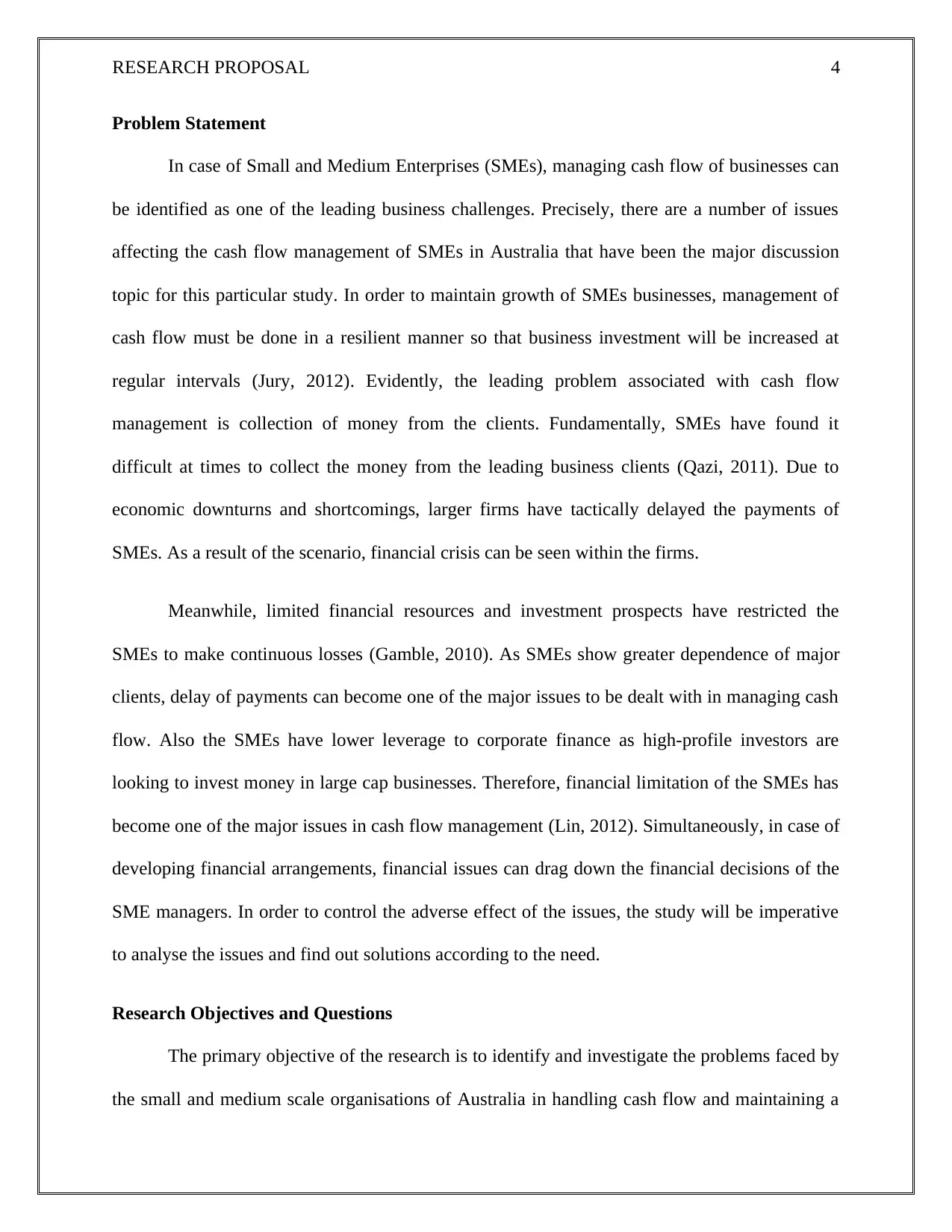
RESEARCH PROPOSAL 4
Problem Statement
In case of Small and Medium Enterprises (SMEs), managing cash flow of businesses can
be identified as one of the leading business challenges. Precisely, there are a number of issues
affecting the cash flow management of SMEs in Australia that have been the major discussion
topic for this particular study. In order to maintain growth of SMEs businesses, management of
cash flow must be done in a resilient manner so that business investment will be increased at
regular intervals (Jury, 2012). Evidently, the leading problem associated with cash flow
management is collection of money from the clients. Fundamentally, SMEs have found it
difficult at times to collect the money from the leading business clients (Qazi, 2011). Due to
economic downturns and shortcomings, larger firms have tactically delayed the payments of
SMEs. As a result of the scenario, financial crisis can be seen within the firms.
Meanwhile, limited financial resources and investment prospects have restricted the
SMEs to make continuous losses (Gamble, 2010). As SMEs show greater dependence of major
clients, delay of payments can become one of the major issues to be dealt with in managing cash
flow. Also the SMEs have lower leverage to corporate finance as high-profile investors are
looking to invest money in large cap businesses. Therefore, financial limitation of the SMEs has
become one of the major issues in cash flow management (Lin, 2012). Simultaneously, in case of
developing financial arrangements, financial issues can drag down the financial decisions of the
SME managers. In order to control the adverse effect of the issues, the study will be imperative
to analyse the issues and find out solutions according to the need.
Research Objectives and Questions
The primary objective of the research is to identify and investigate the problems faced by
the small and medium scale organisations of Australia in handling cash flow and maintaining a
Problem Statement
In case of Small and Medium Enterprises (SMEs), managing cash flow of businesses can
be identified as one of the leading business challenges. Precisely, there are a number of issues
affecting the cash flow management of SMEs in Australia that have been the major discussion
topic for this particular study. In order to maintain growth of SMEs businesses, management of
cash flow must be done in a resilient manner so that business investment will be increased at
regular intervals (Jury, 2012). Evidently, the leading problem associated with cash flow
management is collection of money from the clients. Fundamentally, SMEs have found it
difficult at times to collect the money from the leading business clients (Qazi, 2011). Due to
economic downturns and shortcomings, larger firms have tactically delayed the payments of
SMEs. As a result of the scenario, financial crisis can be seen within the firms.
Meanwhile, limited financial resources and investment prospects have restricted the
SMEs to make continuous losses (Gamble, 2010). As SMEs show greater dependence of major
clients, delay of payments can become one of the major issues to be dealt with in managing cash
flow. Also the SMEs have lower leverage to corporate finance as high-profile investors are
looking to invest money in large cap businesses. Therefore, financial limitation of the SMEs has
become one of the major issues in cash flow management (Lin, 2012). Simultaneously, in case of
developing financial arrangements, financial issues can drag down the financial decisions of the
SME managers. In order to control the adverse effect of the issues, the study will be imperative
to analyse the issues and find out solutions according to the need.
Research Objectives and Questions
The primary objective of the research is to identify and investigate the problems faced by
the small and medium scale organisations of Australia in handling cash flow and maintaining a
Paraphrase This Document
Need a fresh take? Get an instant paraphrase of this document with our AI Paraphraser
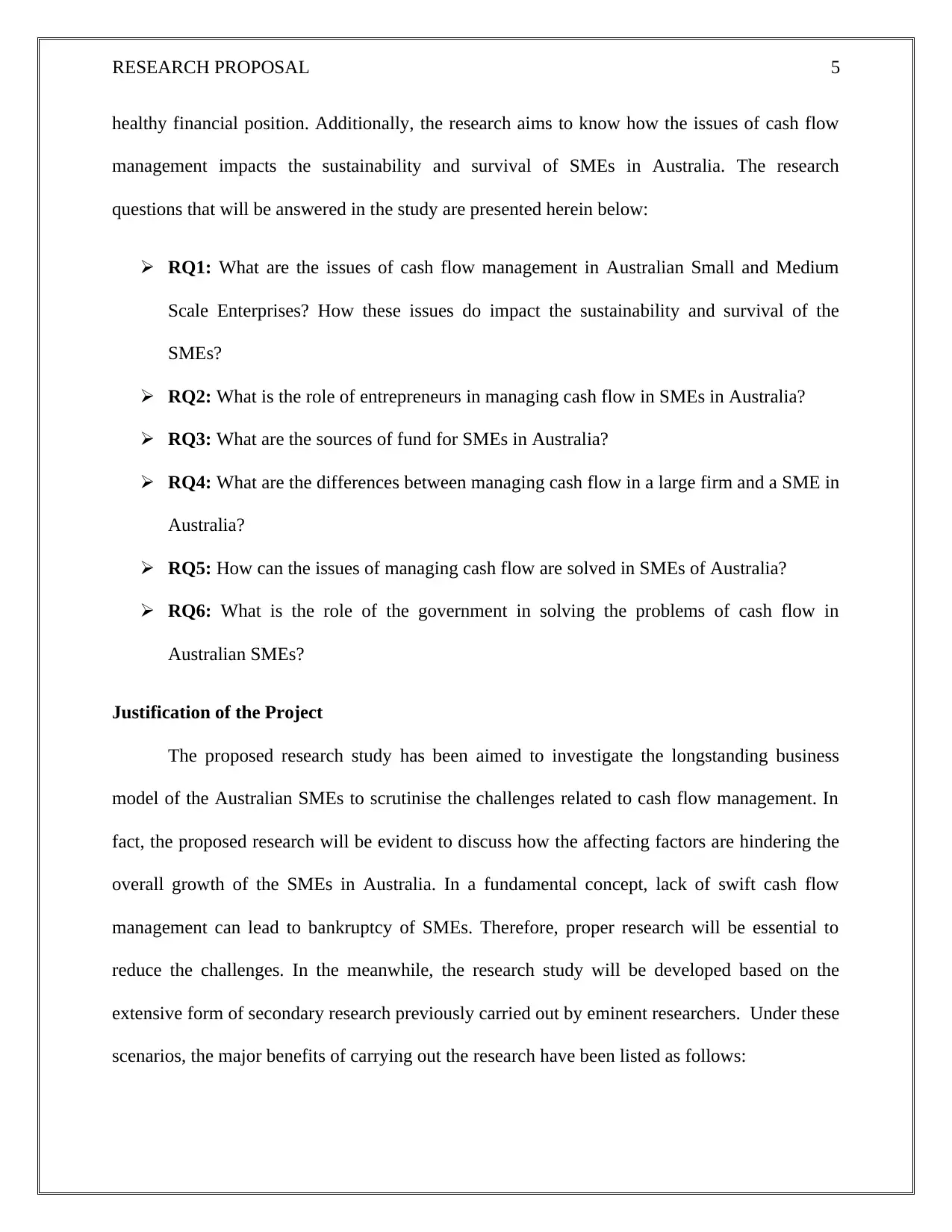
RESEARCH PROPOSAL 5
healthy financial position. Additionally, the research aims to know how the issues of cash flow
management impacts the sustainability and survival of SMEs in Australia. The research
questions that will be answered in the study are presented herein below:
RQ1: What are the issues of cash flow management in Australian Small and Medium
Scale Enterprises? How these issues do impact the sustainability and survival of the
SMEs?
RQ2: What is the role of entrepreneurs in managing cash flow in SMEs in Australia?
RQ3: What are the sources of fund for SMEs in Australia?
RQ4: What are the differences between managing cash flow in a large firm and a SME in
Australia?
RQ5: How can the issues of managing cash flow are solved in SMEs of Australia?
RQ6: What is the role of the government in solving the problems of cash flow in
Australian SMEs?
Justification of the Project
The proposed research study has been aimed to investigate the longstanding business
model of the Australian SMEs to scrutinise the challenges related to cash flow management. In
fact, the proposed research will be evident to discuss how the affecting factors are hindering the
overall growth of the SMEs in Australia. In a fundamental concept, lack of swift cash flow
management can lead to bankruptcy of SMEs. Therefore, proper research will be essential to
reduce the challenges. In the meanwhile, the research study will be developed based on the
extensive form of secondary research previously carried out by eminent researchers. Under these
scenarios, the major benefits of carrying out the research have been listed as follows:
healthy financial position. Additionally, the research aims to know how the issues of cash flow
management impacts the sustainability and survival of SMEs in Australia. The research
questions that will be answered in the study are presented herein below:
RQ1: What are the issues of cash flow management in Australian Small and Medium
Scale Enterprises? How these issues do impact the sustainability and survival of the
SMEs?
RQ2: What is the role of entrepreneurs in managing cash flow in SMEs in Australia?
RQ3: What are the sources of fund for SMEs in Australia?
RQ4: What are the differences between managing cash flow in a large firm and a SME in
Australia?
RQ5: How can the issues of managing cash flow are solved in SMEs of Australia?
RQ6: What is the role of the government in solving the problems of cash flow in
Australian SMEs?
Justification of the Project
The proposed research study has been aimed to investigate the longstanding business
model of the Australian SMEs to scrutinise the challenges related to cash flow management. In
fact, the proposed research will be evident to discuss how the affecting factors are hindering the
overall growth of the SMEs in Australia. In a fundamental concept, lack of swift cash flow
management can lead to bankruptcy of SMEs. Therefore, proper research will be essential to
reduce the challenges. In the meanwhile, the research study will be developed based on the
extensive form of secondary research previously carried out by eminent researchers. Under these
scenarios, the major benefits of carrying out the research have been listed as follows:
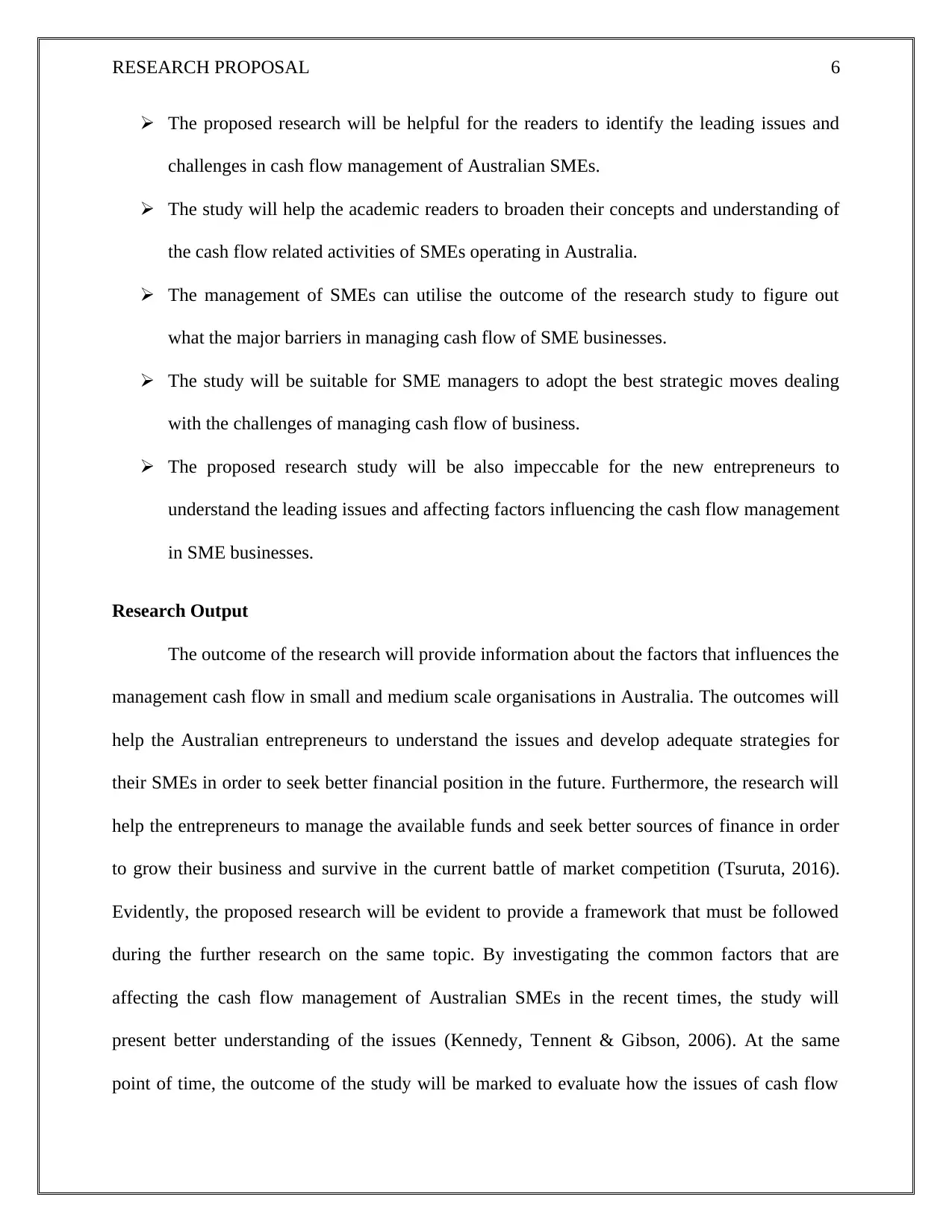
RESEARCH PROPOSAL 6
The proposed research will be helpful for the readers to identify the leading issues and
challenges in cash flow management of Australian SMEs.
The study will help the academic readers to broaden their concepts and understanding of
the cash flow related activities of SMEs operating in Australia.
The management of SMEs can utilise the outcome of the research study to figure out
what the major barriers in managing cash flow of SME businesses.
The study will be suitable for SME managers to adopt the best strategic moves dealing
with the challenges of managing cash flow of business.
The proposed research study will be also impeccable for the new entrepreneurs to
understand the leading issues and affecting factors influencing the cash flow management
in SME businesses.
Research Output
The outcome of the research will provide information about the factors that influences the
management cash flow in small and medium scale organisations in Australia. The outcomes will
help the Australian entrepreneurs to understand the issues and develop adequate strategies for
their SMEs in order to seek better financial position in the future. Furthermore, the research will
help the entrepreneurs to manage the available funds and seek better sources of finance in order
to grow their business and survive in the current battle of market competition (Tsuruta, 2016).
Evidently, the proposed research will be evident to provide a framework that must be followed
during the further research on the same topic. By investigating the common factors that are
affecting the cash flow management of Australian SMEs in the recent times, the study will
present better understanding of the issues (Kennedy, Tennent & Gibson, 2006). At the same
point of time, the outcome of the study will be marked to evaluate how the issues of cash flow
The proposed research will be helpful for the readers to identify the leading issues and
challenges in cash flow management of Australian SMEs.
The study will help the academic readers to broaden their concepts and understanding of
the cash flow related activities of SMEs operating in Australia.
The management of SMEs can utilise the outcome of the research study to figure out
what the major barriers in managing cash flow of SME businesses.
The study will be suitable for SME managers to adopt the best strategic moves dealing
with the challenges of managing cash flow of business.
The proposed research study will be also impeccable for the new entrepreneurs to
understand the leading issues and affecting factors influencing the cash flow management
in SME businesses.
Research Output
The outcome of the research will provide information about the factors that influences the
management cash flow in small and medium scale organisations in Australia. The outcomes will
help the Australian entrepreneurs to understand the issues and develop adequate strategies for
their SMEs in order to seek better financial position in the future. Furthermore, the research will
help the entrepreneurs to manage the available funds and seek better sources of finance in order
to grow their business and survive in the current battle of market competition (Tsuruta, 2016).
Evidently, the proposed research will be evident to provide a framework that must be followed
during the further research on the same topic. By investigating the common factors that are
affecting the cash flow management of Australian SMEs in the recent times, the study will
present better understanding of the issues (Kennedy, Tennent & Gibson, 2006). At the same
point of time, the outcome of the study will be marked to evaluate how the issues of cash flow
⊘ This is a preview!⊘
Do you want full access?
Subscribe today to unlock all pages.

Trusted by 1+ million students worldwide
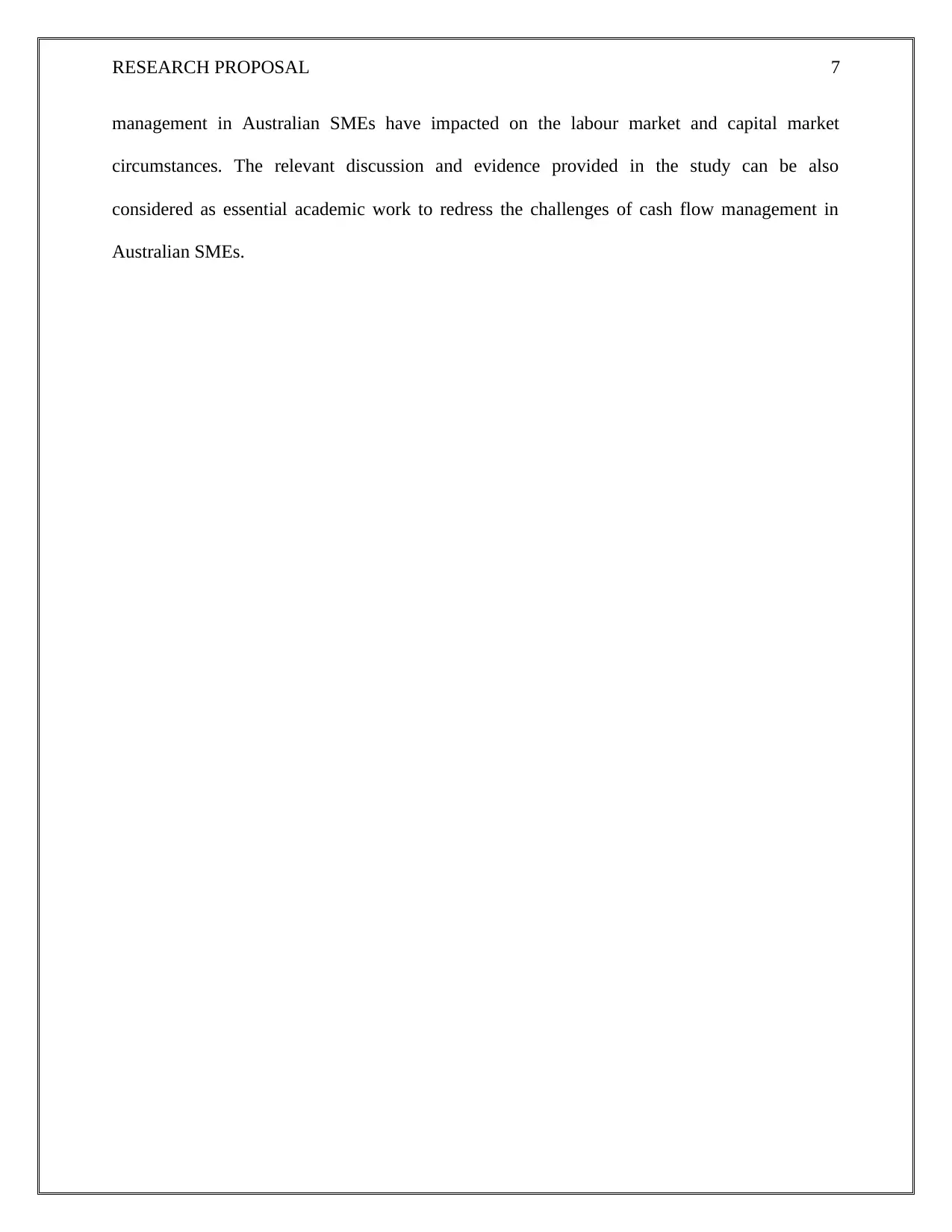
RESEARCH PROPOSAL 7
management in Australian SMEs have impacted on the labour market and capital market
circumstances. The relevant discussion and evidence provided in the study can be also
considered as essential academic work to redress the challenges of cash flow management in
Australian SMEs.
management in Australian SMEs have impacted on the labour market and capital market
circumstances. The relevant discussion and evidence provided in the study can be also
considered as essential academic work to redress the challenges of cash flow management in
Australian SMEs.
Paraphrase This Document
Need a fresh take? Get an instant paraphrase of this document with our AI Paraphraser
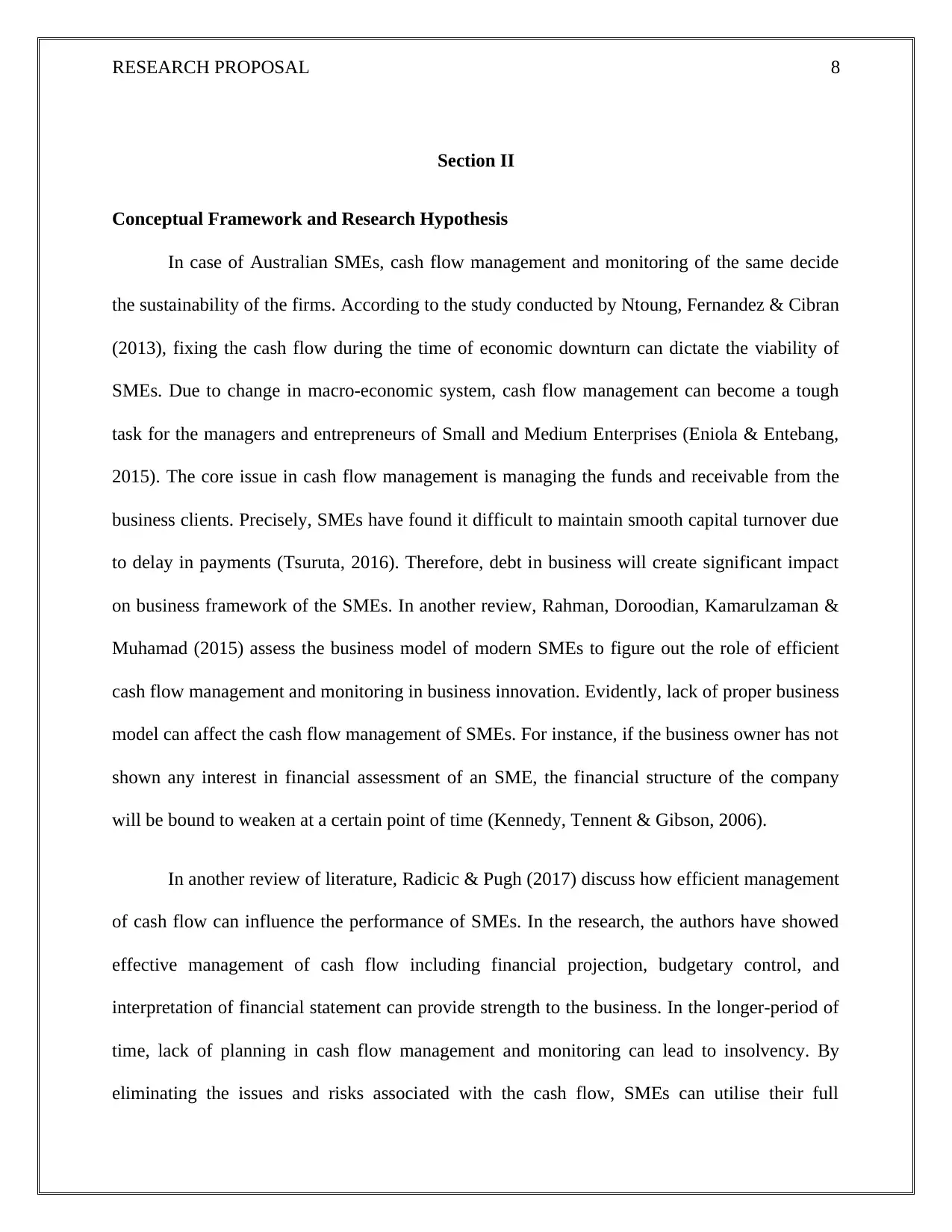
RESEARCH PROPOSAL 8
Section II
Conceptual Framework and Research Hypothesis
In case of Australian SMEs, cash flow management and monitoring of the same decide
the sustainability of the firms. According to the study conducted by Ntoung, Fernandez & Cibran
(2013), fixing the cash flow during the time of economic downturn can dictate the viability of
SMEs. Due to change in macro-economic system, cash flow management can become a tough
task for the managers and entrepreneurs of Small and Medium Enterprises (Eniola & Entebang,
2015). The core issue in cash flow management is managing the funds and receivable from the
business clients. Precisely, SMEs have found it difficult to maintain smooth capital turnover due
to delay in payments (Tsuruta, 2016). Therefore, debt in business will create significant impact
on business framework of the SMEs. In another review, Rahman, Doroodian, Kamarulzaman &
Muhamad (2015) assess the business model of modern SMEs to figure out the role of efficient
cash flow management and monitoring in business innovation. Evidently, lack of proper business
model can affect the cash flow management of SMEs. For instance, if the business owner has not
shown any interest in financial assessment of an SME, the financial structure of the company
will be bound to weaken at a certain point of time (Kennedy, Tennent & Gibson, 2006).
In another review of literature, Radicic & Pugh (2017) discuss how efficient management
of cash flow can influence the performance of SMEs. In the research, the authors have showed
effective management of cash flow including financial projection, budgetary control, and
interpretation of financial statement can provide strength to the business. In the longer-period of
time, lack of planning in cash flow management and monitoring can lead to insolvency. By
eliminating the issues and risks associated with the cash flow, SMEs can utilise their full
Section II
Conceptual Framework and Research Hypothesis
In case of Australian SMEs, cash flow management and monitoring of the same decide
the sustainability of the firms. According to the study conducted by Ntoung, Fernandez & Cibran
(2013), fixing the cash flow during the time of economic downturn can dictate the viability of
SMEs. Due to change in macro-economic system, cash flow management can become a tough
task for the managers and entrepreneurs of Small and Medium Enterprises (Eniola & Entebang,
2015). The core issue in cash flow management is managing the funds and receivable from the
business clients. Precisely, SMEs have found it difficult to maintain smooth capital turnover due
to delay in payments (Tsuruta, 2016). Therefore, debt in business will create significant impact
on business framework of the SMEs. In another review, Rahman, Doroodian, Kamarulzaman &
Muhamad (2015) assess the business model of modern SMEs to figure out the role of efficient
cash flow management and monitoring in business innovation. Evidently, lack of proper business
model can affect the cash flow management of SMEs. For instance, if the business owner has not
shown any interest in financial assessment of an SME, the financial structure of the company
will be bound to weaken at a certain point of time (Kennedy, Tennent & Gibson, 2006).
In another review of literature, Radicic & Pugh (2017) discuss how efficient management
of cash flow can influence the performance of SMEs. In the research, the authors have showed
effective management of cash flow including financial projection, budgetary control, and
interpretation of financial statement can provide strength to the business. In the longer-period of
time, lack of planning in cash flow management and monitoring can lead to insolvency. By
eliminating the issues and risks associated with the cash flow, SMEs can utilise their full
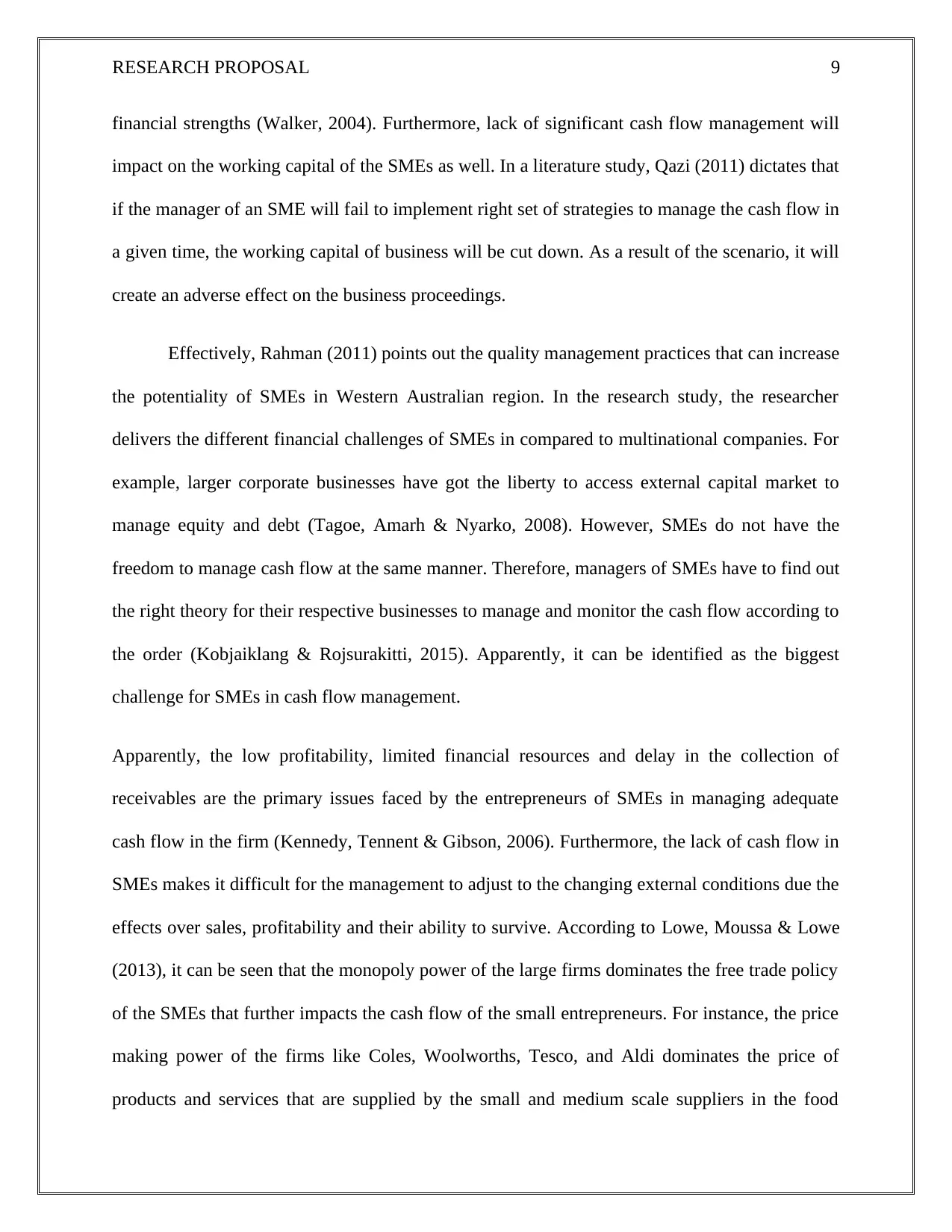
RESEARCH PROPOSAL 9
financial strengths (Walker, 2004). Furthermore, lack of significant cash flow management will
impact on the working capital of the SMEs as well. In a literature study, Qazi (2011) dictates that
if the manager of an SME will fail to implement right set of strategies to manage the cash flow in
a given time, the working capital of business will be cut down. As a result of the scenario, it will
create an adverse effect on the business proceedings.
Effectively, Rahman (2011) points out the quality management practices that can increase
the potentiality of SMEs in Western Australian region. In the research study, the researcher
delivers the different financial challenges of SMEs in compared to multinational companies. For
example, larger corporate businesses have got the liberty to access external capital market to
manage equity and debt (Tagoe, Amarh & Nyarko, 2008). However, SMEs do not have the
freedom to manage cash flow at the same manner. Therefore, managers of SMEs have to find out
the right theory for their respective businesses to manage and monitor the cash flow according to
the order (Kobjaiklang & Rojsurakitti, 2015). Apparently, it can be identified as the biggest
challenge for SMEs in cash flow management.
Apparently, the low profitability, limited financial resources and delay in the collection of
receivables are the primary issues faced by the entrepreneurs of SMEs in managing adequate
cash flow in the firm (Kennedy, Tennent & Gibson, 2006). Furthermore, the lack of cash flow in
SMEs makes it difficult for the management to adjust to the changing external conditions due the
effects over sales, profitability and their ability to survive. According to Lowe, Moussa & Lowe
(2013), it can be seen that the monopoly power of the large firms dominates the free trade policy
of the SMEs that further impacts the cash flow of the small entrepreneurs. For instance, the price
making power of the firms like Coles, Woolworths, Tesco, and Aldi dominates the price of
products and services that are supplied by the small and medium scale suppliers in the food
financial strengths (Walker, 2004). Furthermore, lack of significant cash flow management will
impact on the working capital of the SMEs as well. In a literature study, Qazi (2011) dictates that
if the manager of an SME will fail to implement right set of strategies to manage the cash flow in
a given time, the working capital of business will be cut down. As a result of the scenario, it will
create an adverse effect on the business proceedings.
Effectively, Rahman (2011) points out the quality management practices that can increase
the potentiality of SMEs in Western Australian region. In the research study, the researcher
delivers the different financial challenges of SMEs in compared to multinational companies. For
example, larger corporate businesses have got the liberty to access external capital market to
manage equity and debt (Tagoe, Amarh & Nyarko, 2008). However, SMEs do not have the
freedom to manage cash flow at the same manner. Therefore, managers of SMEs have to find out
the right theory for their respective businesses to manage and monitor the cash flow according to
the order (Kobjaiklang & Rojsurakitti, 2015). Apparently, it can be identified as the biggest
challenge for SMEs in cash flow management.
Apparently, the low profitability, limited financial resources and delay in the collection of
receivables are the primary issues faced by the entrepreneurs of SMEs in managing adequate
cash flow in the firm (Kennedy, Tennent & Gibson, 2006). Furthermore, the lack of cash flow in
SMEs makes it difficult for the management to adjust to the changing external conditions due the
effects over sales, profitability and their ability to survive. According to Lowe, Moussa & Lowe
(2013), it can be seen that the monopoly power of the large firms dominates the free trade policy
of the SMEs that further impacts the cash flow of the small entrepreneurs. For instance, the price
making power of the firms like Coles, Woolworths, Tesco, and Aldi dominates the price of
products and services that are supplied by the small and medium scale suppliers in the food
⊘ This is a preview!⊘
Do you want full access?
Subscribe today to unlock all pages.

Trusted by 1+ million students worldwide
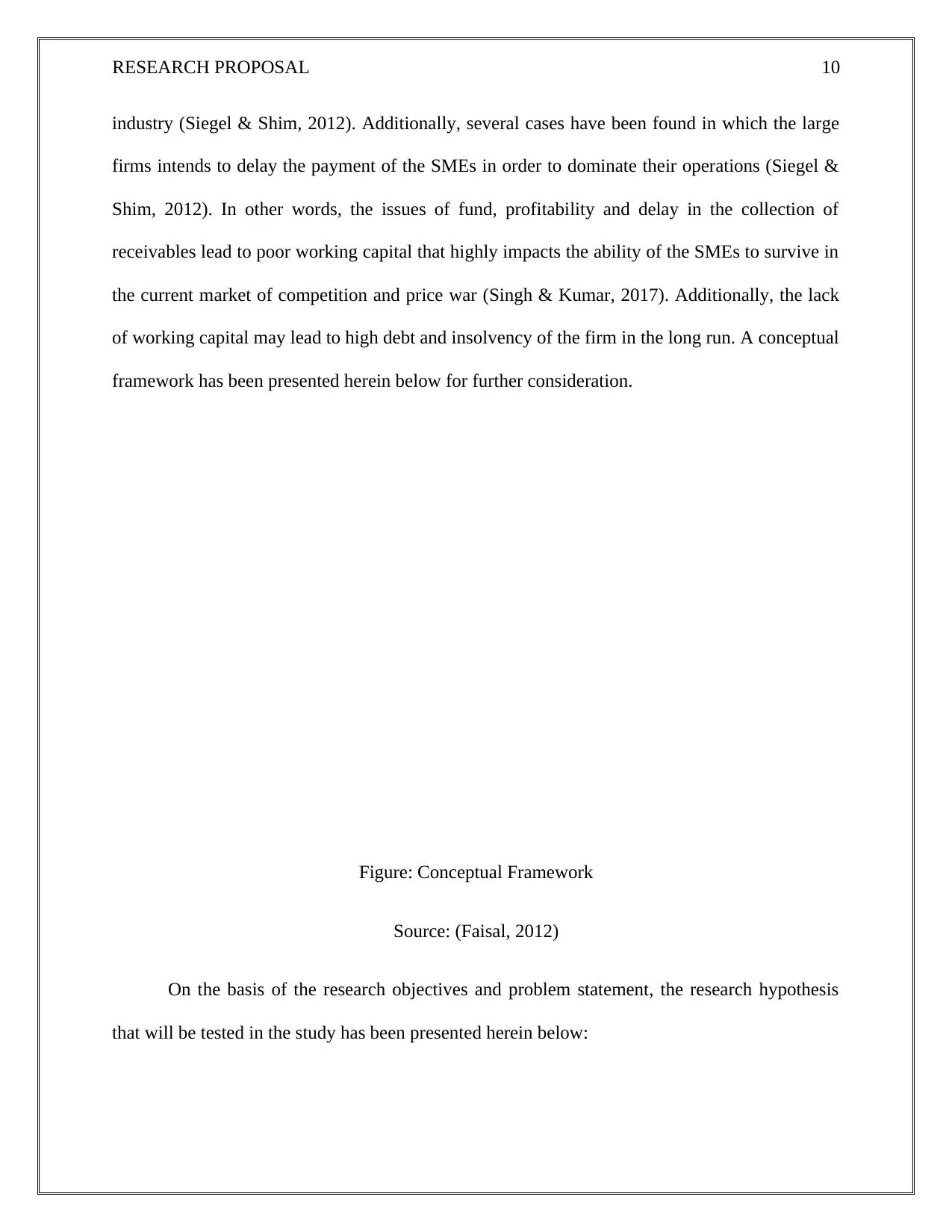
RESEARCH PROPOSAL 10
industry (Siegel & Shim, 2012). Additionally, several cases have been found in which the large
firms intends to delay the payment of the SMEs in order to dominate their operations (Siegel &
Shim, 2012). In other words, the issues of fund, profitability and delay in the collection of
receivables lead to poor working capital that highly impacts the ability of the SMEs to survive in
the current market of competition and price war (Singh & Kumar, 2017). Additionally, the lack
of working capital may lead to high debt and insolvency of the firm in the long run. A conceptual
framework has been presented herein below for further consideration.
Figure: Conceptual Framework
Source: (Faisal, 2012)
On the basis of the research objectives and problem statement, the research hypothesis
that will be tested in the study has been presented herein below:
industry (Siegel & Shim, 2012). Additionally, several cases have been found in which the large
firms intends to delay the payment of the SMEs in order to dominate their operations (Siegel &
Shim, 2012). In other words, the issues of fund, profitability and delay in the collection of
receivables lead to poor working capital that highly impacts the ability of the SMEs to survive in
the current market of competition and price war (Singh & Kumar, 2017). Additionally, the lack
of working capital may lead to high debt and insolvency of the firm in the long run. A conceptual
framework has been presented herein below for further consideration.
Figure: Conceptual Framework
Source: (Faisal, 2012)
On the basis of the research objectives and problem statement, the research hypothesis
that will be tested in the study has been presented herein below:
Paraphrase This Document
Need a fresh take? Get an instant paraphrase of this document with our AI Paraphraser
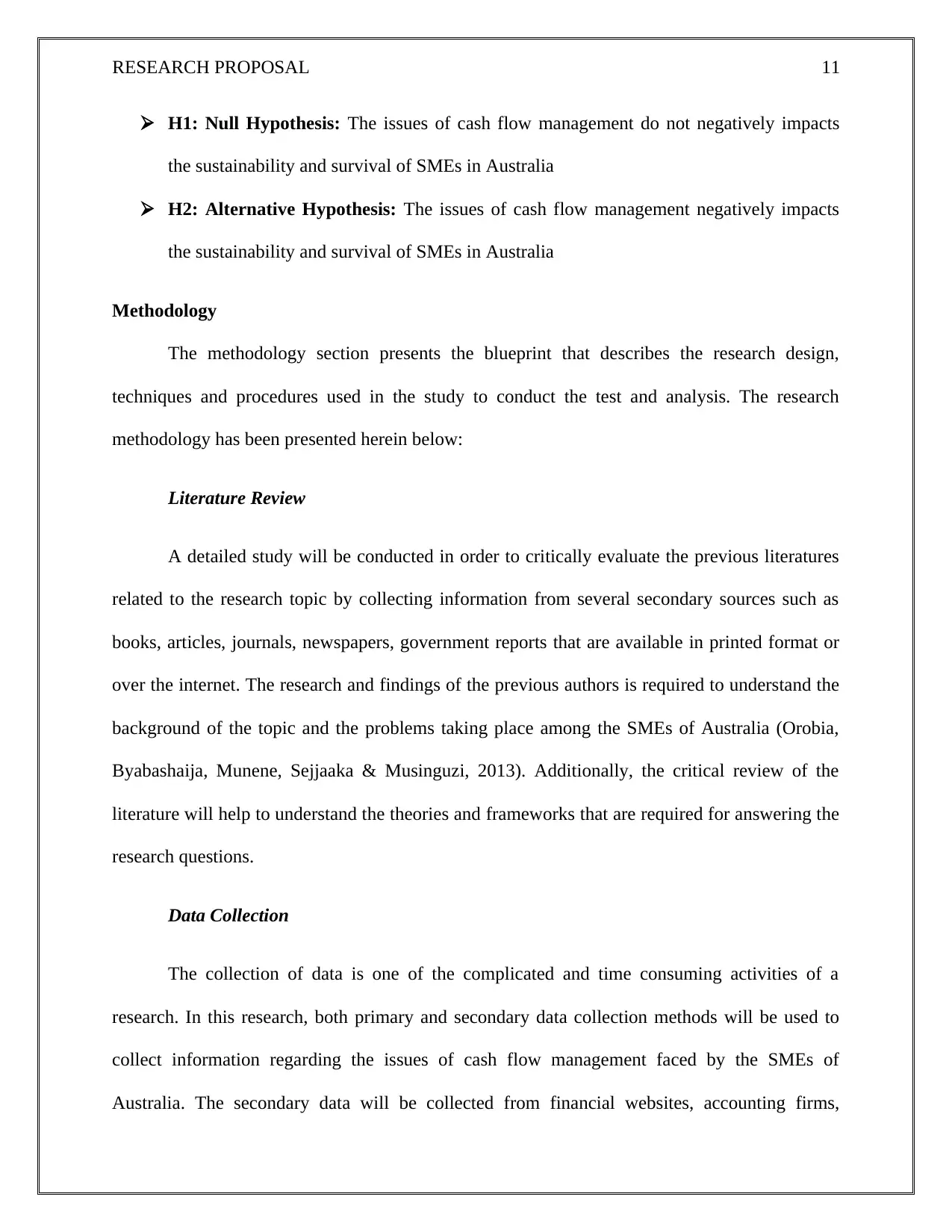
RESEARCH PROPOSAL 11
H1: Null Hypothesis: The issues of cash flow management do not negatively impacts
the sustainability and survival of SMEs in Australia
H2: Alternative Hypothesis: The issues of cash flow management negatively impacts
the sustainability and survival of SMEs in Australia
Methodology
The methodology section presents the blueprint that describes the research design,
techniques and procedures used in the study to conduct the test and analysis. The research
methodology has been presented herein below:
Literature Review
A detailed study will be conducted in order to critically evaluate the previous literatures
related to the research topic by collecting information from several secondary sources such as
books, articles, journals, newspapers, government reports that are available in printed format or
over the internet. The research and findings of the previous authors is required to understand the
background of the topic and the problems taking place among the SMEs of Australia (Orobia,
Byabashaija, Munene, Sejjaaka & Musinguzi, 2013). Additionally, the critical review of the
literature will help to understand the theories and frameworks that are required for answering the
research questions.
Data Collection
The collection of data is one of the complicated and time consuming activities of a
research. In this research, both primary and secondary data collection methods will be used to
collect information regarding the issues of cash flow management faced by the SMEs of
Australia. The secondary data will be collected from financial websites, accounting firms,
H1: Null Hypothesis: The issues of cash flow management do not negatively impacts
the sustainability and survival of SMEs in Australia
H2: Alternative Hypothesis: The issues of cash flow management negatively impacts
the sustainability and survival of SMEs in Australia
Methodology
The methodology section presents the blueprint that describes the research design,
techniques and procedures used in the study to conduct the test and analysis. The research
methodology has been presented herein below:
Literature Review
A detailed study will be conducted in order to critically evaluate the previous literatures
related to the research topic by collecting information from several secondary sources such as
books, articles, journals, newspapers, government reports that are available in printed format or
over the internet. The research and findings of the previous authors is required to understand the
background of the topic and the problems taking place among the SMEs of Australia (Orobia,
Byabashaija, Munene, Sejjaaka & Musinguzi, 2013). Additionally, the critical review of the
literature will help to understand the theories and frameworks that are required for answering the
research questions.
Data Collection
The collection of data is one of the complicated and time consuming activities of a
research. In this research, both primary and secondary data collection methods will be used to
collect information regarding the issues of cash flow management faced by the SMEs of
Australia. The secondary data will be collected from financial websites, accounting firms,
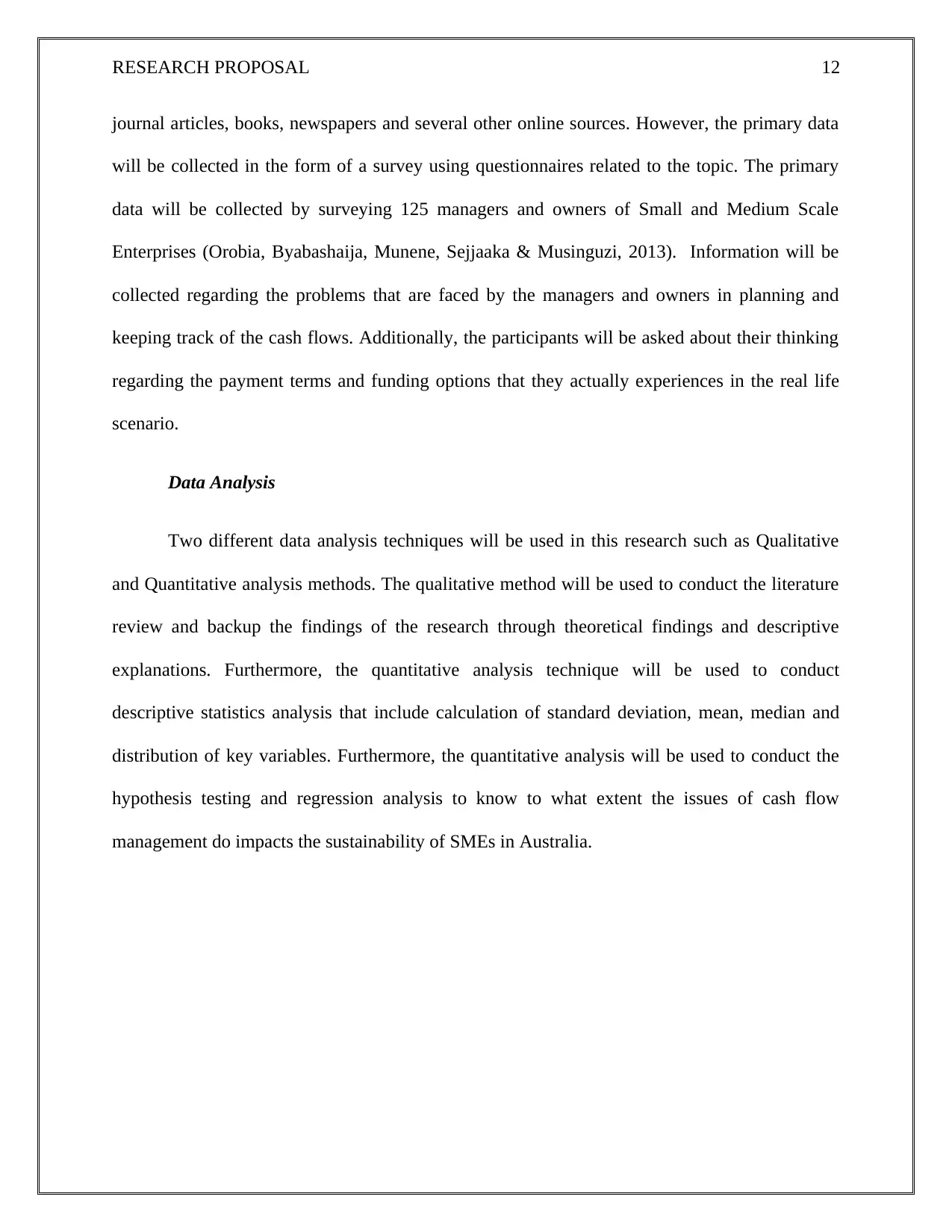
RESEARCH PROPOSAL 12
journal articles, books, newspapers and several other online sources. However, the primary data
will be collected in the form of a survey using questionnaires related to the topic. The primary
data will be collected by surveying 125 managers and owners of Small and Medium Scale
Enterprises (Orobia, Byabashaija, Munene, Sejjaaka & Musinguzi, 2013). Information will be
collected regarding the problems that are faced by the managers and owners in planning and
keeping track of the cash flows. Additionally, the participants will be asked about their thinking
regarding the payment terms and funding options that they actually experiences in the real life
scenario.
Data Analysis
Two different data analysis techniques will be used in this research such as Qualitative
and Quantitative analysis methods. The qualitative method will be used to conduct the literature
review and backup the findings of the research through theoretical findings and descriptive
explanations. Furthermore, the quantitative analysis technique will be used to conduct
descriptive statistics analysis that include calculation of standard deviation, mean, median and
distribution of key variables. Furthermore, the quantitative analysis will be used to conduct the
hypothesis testing and regression analysis to know to what extent the issues of cash flow
management do impacts the sustainability of SMEs in Australia.
journal articles, books, newspapers and several other online sources. However, the primary data
will be collected in the form of a survey using questionnaires related to the topic. The primary
data will be collected by surveying 125 managers and owners of Small and Medium Scale
Enterprises (Orobia, Byabashaija, Munene, Sejjaaka & Musinguzi, 2013). Information will be
collected regarding the problems that are faced by the managers and owners in planning and
keeping track of the cash flows. Additionally, the participants will be asked about their thinking
regarding the payment terms and funding options that they actually experiences in the real life
scenario.
Data Analysis
Two different data analysis techniques will be used in this research such as Qualitative
and Quantitative analysis methods. The qualitative method will be used to conduct the literature
review and backup the findings of the research through theoretical findings and descriptive
explanations. Furthermore, the quantitative analysis technique will be used to conduct
descriptive statistics analysis that include calculation of standard deviation, mean, median and
distribution of key variables. Furthermore, the quantitative analysis will be used to conduct the
hypothesis testing and regression analysis to know to what extent the issues of cash flow
management do impacts the sustainability of SMEs in Australia.
⊘ This is a preview!⊘
Do you want full access?
Subscribe today to unlock all pages.

Trusted by 1+ million students worldwide
1 out of 18
Related Documents
Your All-in-One AI-Powered Toolkit for Academic Success.
+13062052269
info@desklib.com
Available 24*7 on WhatsApp / Email
![[object Object]](/_next/static/media/star-bottom.7253800d.svg)
Unlock your academic potential
Copyright © 2020–2025 A2Z Services. All Rights Reserved. Developed and managed by ZUCOL.





